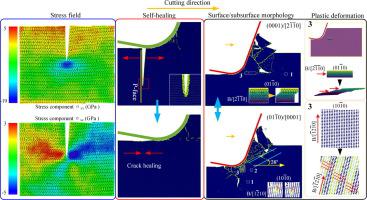Journal of Advanced Research ( IF 10.7 ) Pub Date : 2023-04-13 , DOI: 10.1016/j.jare.2023.04.004 Binbin Meng 1 , Chen Li 2

|
Introduction
Monocrystal SiC is representative of the third generation semiconductor materials, the efficient process technology of 6H-SiC wafer have always been a hot topic. Developing a SPDT processing method based on brittle removal mode with controllable surface/subsurface damage is an important approach to solve the processing difficulties of 6H-SiC.
Objectives
This work aims to analyze the brittle removal process and fully explain the brittle separation behavior and deformation mechanism of 6H-SiC. The micro-scale crack propagation and the effect of anisotropy on crack distribution during machining process are investigated.
Methods
Large-scale molecular dynamics simulation was used in this work.
Results
Under the condition of brittle removal, shear fracture occurs in the front area of tool tip. Shear plane is high-index surface, independent of slip system. The location of tensile fracture is the cleavage plane of hexagonal system, and the fracture surface is composed of step-like joint planes or perfect plane structures. Cracks with self-healing capability appear in the area behind the tool when the surface to be machined is basal plane. When the surface to be machined is not basal plane, a large number of dislocations or cracks remain in subsurface region. Under brittle removal mode, a large amount of plastic deformation appears as well, and deformation mode is related to processing scheme.
Conclusion
The brittle removal behavior of 6H-SiC under SPDT process has obvious anisotropy. Basal plane is more suitable for brittle removal of 6H-SiC without residual damage such as sub-surface cracks. The crack behind the tool generated by cleavage fracture can be repaired by itself. Fracture behavior is not related to dislocation. The processing method parallel to the c-axis can cause the generation of a large number of surface cracks. The ()/[] and ()/[] mode is the best way to achieve plastic removal of 6H-SiC during SPDT process.
中文翻译:

SPDT过程中各向异性对6H-SiC去脆变形和裂纹形成的影响
介绍
单晶SiC作为第三代半导体材料的代表,6H-SiC晶圆的高效工艺技术一直是人们关注的热点。开发基于表面/亚表面损伤可控的脆性去除模式的SPDT加工方法是解决6H-SiC加工难点的重要途径。
目标
本工作旨在分析6H-SiC的脆性去除过程,充分解释6H-SiC的脆性分离行为和变形机制。研究了加工过程中微尺度裂纹扩展以及各向异性对裂纹分布的影响。
方法
这项工作使用了大规模分子动力学模拟。
结果
在脆性去除的情况下,刀尖前端区域发生剪切断裂。剪切面为高指数面,与滑移系统无关。拉伸断裂位置为六方晶系解理面,断裂面由阶梯状节理面或完美平面结构组成。当待加工表面为基面时,具有自愈能力的裂纹出现在刀具后面的区域。当待加工表面不是基面时,亚表面区域会残留大量位错或裂纹。在脆性去除模式下,也会出现大量的塑性变形,变形方式与加工方案有关。
结论
SPDT工艺下6H-SiC的除脆行为具有明显的各向异性。基面更适合6H-SiC的脆性去除,无亚表面裂纹等残余损伤。解理断裂产生的刀具后面的裂纹可以自行修复。骨折行为与脱位无关。平行于c轴的加工方法会导致大量表面裂纹的产生。这 ()/[] 和 ()/[] 模式是在 SPDT 工艺中实现 6H-SiC 塑性去除的最佳方式。


























 京公网安备 11010802027423号
京公网安备 11010802027423号